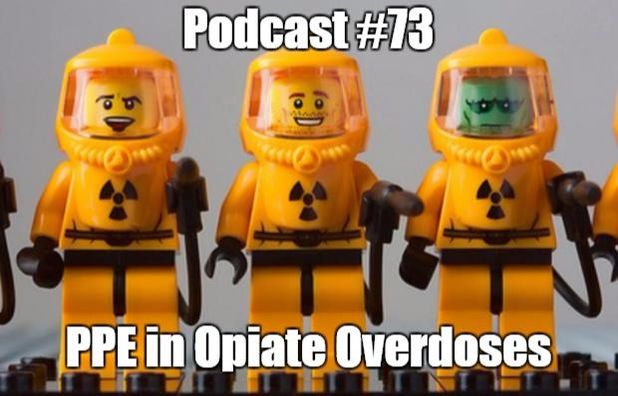|
We hear plenty on the news about the opioid crisis, but we are hearing more and more about exposure to these opiates potentially harming first responders and even those in the emergency department. It begs the question, how much is enough in regards to personal protective equipment (PPE)?
The lay media has sensationalized exposures to potent opioids among individuals, especially law enforcement, with many important facts and details missing from the stories. The DEA even released a statement along the same lines. First, the chances of inadvertent contact with a substance is unlikely and furthermore a poisoning from this exposure would be incredibly rare. This is thanks mainly to the poor absorption of such opiates through the skin. Although fentanyl patches exist, the delivery mechanism is rather unique from the powder or tablet exposure that would most likely be exposed to those treating the patient. Even if toxicity were to somehow occur, it would be very slow in progression allowing said person plenty of time to remove the substance in a safe matter.
For those treating opiate overdose patients, in the routine care of such patients nitrile gloves should be more than sufficient and is recommended by multiple groups as the main source of protection in such scenarios. None of them specify the thick gloves we see coming from EMS and EDs currently, but there are new gloves out on the market to “combat” this very issue. Most likely, these are not necessary given the above stated pharmacodynamics. Some may ask about ocular and facial exposure risks. Although fentanyl and its derivatives do have an affinity for absorption (approximately 30 fold) for mucous membranes compared to skin, such exposure would be incredibly rare. There has been a case report of a veterinarian who was splash in the eyes and mouth due to a dart containing 1.5mg of carfentanil and 50mg of xylazine. He did immediately clean the area but became drowsy within two minutes and responded promptly to naltrexone. However, it is not clear if this was truly due to the carfentanil. In the incredibly rare case that such as exposure could occur, simple splash protection that is OSHA rated should be sufficient. The other main concern is to inhalation exposure given fentanyl’s potentially high bioavailability (from 12-100%) by inhalation. This is the one most likely to pose an actual risk to those caring for opiate overdose patients but again unlikely. The vapor pressure of fentanyl is very low (4.6 x 10-6 Pa) so evaporation into a gaseous product would not be practical. It could be aerosolized and this has been suspected in a Moscow theater in 2002 when a weaponized version of carfentanil and remifentanil were most likely used to subdue hostage-takers but killed 125 people in the process. However, it is worth noting that in regulated industrial production of fentanyl, the occupational exposure limits using a time-weighted average (OEL-TWA) is 0.1mcg/m3 for fentanyl to limit exposure. At its highest airborne concentration, it would require approximately 200 minutes of exposure to reach a dose of 100mcg of fentanyl if they were unprotected. Even in a rare circumstance where there could be an inhalation risk, a simple N95 mask that has been properly fitted would be very reasonable. No matter the route of exposure, we are looking for and treating respiratory depression and hypoxemia. Initial management isnaloxone and up to 14mg has been used in limited data with benefit. However, there may be instances where higher doses could be of potential benefit. Administration of naloxone should not delay airway management and ventilation especially if these resources are present. In summary, the likelihood that someone caring for an opiate overdose patient to be poisoned themselves is incredibly rare and would require a rather significant and possibly prolonged exposure. Nitrile gloves are sufficient in most cases. In a heavily contaminated enclosed environment, other measures such as water resistant coveralls can be used. If skin is exposed, thoroughly wash the area with water but avoid alcohol based hand sanitizers as this does not wash the product from the skin and could increase absorption. In the concern of splash or mucous membrane exposure, OSHA-approved eye and face protection should be utilized. Properly fitted N95 masks can be used if there is significant airborne suspension of powdered opiates. Most importantly, always be safe. Work with a partner and keep an eye out for other dangers. The more likely threat is something other than the drugs itself. As mentioned in the podcast, both ToxNow and The Poison Review have discussed this issue in detail and it is worth listening to the experts. What future topics would you like us to discuss in future posts? Let us know what you think by giving us feedback here in the comments section or contacting us on Twitter or Facebook. Remember to look us up on Libsyn and on iTunes. If you have any questions you can also comment below, email at [email protected], or send a message from the page. We hope to talk to everyone again soon. Until then, continue to provide total care everywhere.
2 Comments
PA Manela
12/12/2017 04:07:49 pm
Was the vet with the ophthalmic exposure treated with naltrexone or naloxone? Just out of curiosity.
Reply
Chip Lange, PA-C
12/12/2017 05:01:28 pm
Thanks for your comments and glad you enjoyed the blog and podcast. The original paper says naltrexone and this is most likely since vets have easier access to this medication. Naloxone would work in such an overdose, as well.
Reply
Leave a Reply. |
Libsyn and iTunesWe are now on Libsyn and iTunes for your listening pleasure! Archives
August 2022
Categories |
||||||


 RSS Feed
RSS Feed